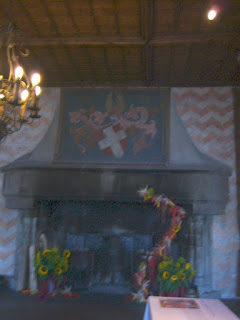Castle Basics
Chillon
Chillon
Castle interior design did not include closets. People used wardrobes - large and bulky; or these movable chests that could then be packed and sent on with the owner to the next castle stop. To the equivalent of Miami for the Season, or perhaps to the next place where tolls were being collected and books had to be audited.
.
 Clothing chests, or other household goods, wooden-carved, Chillon Castle, Switzerland
Clothing chests, or other household goods, wooden-carved, Chillon Castle, SwitzerlandSome chests are religious in theme, others secular. As today, it all depends on your predilection. Here is Adam and Eve, the snake now morphed into a female representation, when the Bible says the Snake is a "he." All to suit the increasing masculinization of the Church? Start trashing the ladies? Above is a contemporary merchant kind of dress on the people represented.
 Religious theme: Adam and Eve and, oh, no, a female snake (the Bible says the snake was a "he"); all the better for dogma, my dear. Castle Chillon, Switzerland
Religious theme: Adam and Eve and, oh, no, a female snake (the Bible says the snake was a "he"); all the better for dogma, my dear. Castle Chillon, SwitzerlandThis kind of wardrobe - armor - would not fit into the chests. Women in armor. Look at the shape, second from the left. Then fast forward to other collections of armor, say, at Thun, Switzerland. Unh-hunh. Amazing how a cultural need to box in a group succeeds just by never mentioning. Let the evidence just slide by, so nobody's antennae are set in that direction. Is that so?
 Women in War. Woman's armor? Chillon Castle collection, second from left, Switzerland
Women in War. Woman's armor? Chillon Castle collection, second from left, SwitzerlandFirebacks are familiar but have a longer history than we may think. A fireback is a cast iron backer that deflects and absorbs and radiates back into the room the heat, away from the rock stone fireplace, where such heat can lead to cracking over time. Let the fireback crack first. See ://www.fireback.com/ for American colonial firebacks. Can't remember the theme of this one: should have made a note.
 Fireback, Chillon Castle, Switzerland
Fireback, Chillon Castle, SwitzerlandHow to keep warm. Small fireplaces had iron firebacks to reflect heat back into the room. Beds had constructions available for curtains, and little roofs to them of solid wood instead of just fabric canopies for additional warmth. We were told that the mattress, just a few inches of something, sat directly on a wooden platform.
 Bed, Chillon Castle, Switzerland; portable. Guide said Duke took furnishings with him castle to castle.
Bed, Chillon Castle, Switzerland; portable. Guide said Duke took furnishings with him castle to castle.Roofs served many functions inside and out: here, outside, the roof to the battlements were solid, for weather-proofing, as well as to withstand invaders' weapons and fire arrows. Hurling weapons at each other, including setting fire to them and then firing them off, has a long history among enemies, see History of Rocketry at ://www.spacearium.com/special/spaceline/spaceline.org/history/1.html
 Roofed battlements structure, post and beam, Chillon Castle, Lake Geneva, Switzerland
Roofed battlements structure, post and beam, Chillon Castle, Lake Geneva, SwitzerlandThe roofing was not only protection for the fighters beneath, but also could deflect a fire weapon into the courtyard where somebody else could cope.
Medieval post and beam structure: here on battlements.
 Large medieval fireplace with overhang, not heat-efficient, Chillon Castle, Switzerland
Large medieval fireplace with overhang, not heat-efficient, Chillon Castle, SwitzerlandIn fireplaces, even the huge ones, most heat went straight up. It took the later wood-burning stove, or coal burning, with its ducts leading hot air to different floors and rooms, to make large places livable without an active fireplace in each room. See Europe Road Ways, Themes, Wood-Burning Stoves.
 Security checkpoints, Castle Chillon, defenses.
Security checkpoints, Castle Chillon, defenses.
No comments:
Post a Comment